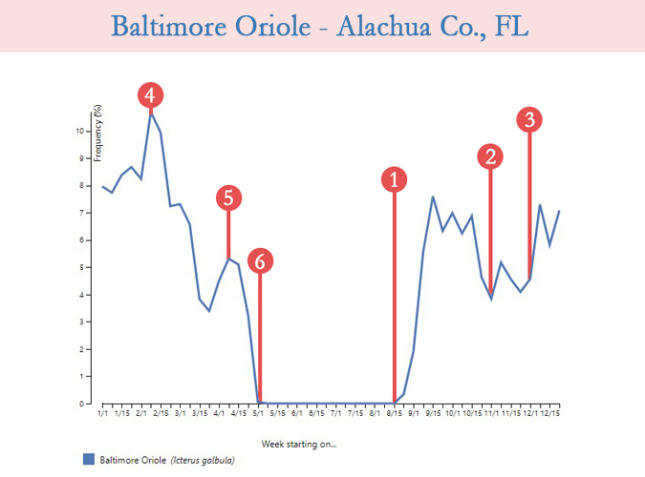All you need to know about the status and distribution of Baltimore Oriole in Alachua County, FL

Follow along from point 1 to point 6 as I explain how this chart shows you everything you need to know about the status and distribution of the Baltimore Oriole (BAOR) in Alachua County, FL over the course of a year. I'm writing this article on September 8, 2020. That's why Point 1 is where it is.
Point 1
BAOR migration begins in the latter half of August. Note that there is no activity in Alachua County all summer long. That is true of every county in Florida. BAOR does not breed in Florida and I do not believe that there has ever been a record of it. However, they do breed as far south as Alabama, Mississippi, and Central Georgia so it doesn't take long for them to begin arriving in Florida once migration has begun.
Point 2
Migrants travelling on through to overwintering grounds from as far north as Mexico and as far south as Colombia and Venezuela have arrived and that main phase of migration is complete. Point 2 actually represents a new trough in activity level but note that frequency remains far above zero. That's because many of the birds that have arrived in Alachua County during the first phase of migration will remain. The yards in which BAOR are observed on a yearly basis get some of their overwintering birds this early.
Point 3
Many BAOR remain as far north as Maine into late fall although they are pretty much plastered against the Atlantic Coast. The uptick in activity that you see around the third week of November occurs because these lingering orioles comprise a second, more gradual wave of migration into points as far south as Central Florida. Indeed, we do seem to be somewhat lucky here in North Central Florida because BAOR really don't go much further in any real density yet we commonly observe them in flocks up to several dozen birds thick all winter long. This doesn't happen much further east although BAOR do overwinter all the way to the Atlantic Coast of Florida and it doesn't happen much further south although BAOR are scattered in lower densities throughout the Greater Antilles.
Point 4
The true peak in overwintering activity occurs around the second week of February as the orioles lingering up the Eastern Seaboard have almost all sought refuge in the deep Southeast. Almost as soon as the southward movement ceases, a return north of the very same birds begins and our overwintering peak begins to decline.
Point 5
Right about the time that we begin to lament the decrease in BAOR activity, spring migration peaks in the first two week of April and numbers rebound, sometimes strongly, at feeders in the area. That rebound is much shorter than the overwintering period but it is a nice little last hurrah before every BAOR leaves the state for breeding season.
Point 6
The true end of BAOR season is in the first week of May every year. About halfway between points 5 and 6, most orioles reported are likely from the avid birding community.

